
Greater Queens Podiatry, PLLC
 (718) 229-0222
(718) 229-0222
 (718) 229-0222
(718) 229-0222 There are many different causes of numbness in your feet, ranging from trivial to potentially very serious. If your feet and legs are “falling asleep,” this is usually do to compression of the nerves. Because of this pressure, the nerves are not receiving the proper amount of blood and they are not able to communicate properly with the brain. Poor blood circulation to the lower extremities, especially the feet, can be a symptom of neuropathy. Diabetics should always take care to check their feet and make sure that nothing seems numb. Poor circulation might also be an indicator of peripheral artery disease (PAD). Make sure to see a podiatrist if you have numbness or feel that you have lack of blood flow to your feet.
There are many different causes of numbness in your feet, ranging from trivial to potentially very serious. If your feet and legs are “falling asleep,” this is usually do to compression of the nerves. Because of this pressure, the nerves are not receiving the proper amount of blood and they are not able to communicate properly with the brain. Poor blood circulation to the lower extremities, especially the feet, can be a symptom of neuropathy. Diabetics should always take care to check their feet and make sure that nothing seems numb. Poor circulation might also be an indicator of peripheral artery disease (PAD). Make sure to see a podiatrist if you have numbness or feel that you have lack of blood flow to your feet.
Poor circulation is a serious condition and needs immediate medical attention. If you have any concerns with poor circulation in your feet contact our podiatrists of Greater Queens Podiatry, PLLC. Our doctors will treat your foot and ankle needs.
Poor Circulation in the Feet
Poor blood circulation in the feet and legs is can be caused by peripheral artery disease (PAD), which is the result of a buildup of plaque in the arteries.
Plaque buildup or atherosclerosis results from excess calcium and cholesterol in the bloodstream. This can restrict the amount of blood which can flow through the arteries. Poor blood circulation in the feet and legs are sometimes caused by inflammation in the blood vessels, known as vasculitis.
Causes
Lack of oxygen and oxygen from poor blood circulation restricts muscle growth and development. It can also cause:
Those who have diabetes or smoke are at greatest risk for poor circulation, as are those who are over 50. If you have poor circulation in the feet and legs it may be caused by PAD and is important to make changes to your lifestyle in order to reduce risk of getting a heart attack or stroke. Exercise and maintaining a healthy lifestyle will dramatically improve conditions.
As always, see a podiatrist as he or she will assist in finding a regimen that suits you. A podiatrist can also prescribe you any needed medication.
If you have any questions please feel free to contact our office located in Bayside, NY. We offer the newest diagnostic and treatment technologies for all your foot and ankle needs.
Read more about Causes, Symptoms, and Treatment of Poor Blood Circulation in the Feet Pharmaceutical company Centrexion Therapeutics recently announced the positive trial results of its latest injectable therapy, CNTX-4975. The therapy is a non-opioid that draws from the painkilling capacity of capsaicin, a constituent of chili peppers. CNTX-4975 is in late-stage development for the treatment of pain from Morton’s neuroma and osteoarthritis. Morton’s neuroma is a condition that develops due to the swelling of the tissue surrounding one of the nerves leading to the toes. It often manifests into a sharp pain in the ball of the foot. Pain relief from a single injection of CNTX-4975 has been shown to last for six months.
Pharmaceutical company Centrexion Therapeutics recently announced the positive trial results of its latest injectable therapy, CNTX-4975. The therapy is a non-opioid that draws from the painkilling capacity of capsaicin, a constituent of chili peppers. CNTX-4975 is in late-stage development for the treatment of pain from Morton’s neuroma and osteoarthritis. Morton’s neuroma is a condition that develops due to the swelling of the tissue surrounding one of the nerves leading to the toes. It often manifests into a sharp pain in the ball of the foot. Pain relief from a single injection of CNTX-4975 has been shown to last for six months.
Morton’s neuroma is a very uncomfortable condition to live with. If you think you have Morton’s neuroma, contact our podiatrists of Greater Queens Podiatry, PLLC. Our doctors will attend to all of your foot and ankle needs and answer any of your related questions.
Morton’s Neuroma
Morton's neuroma is a painful foot condition that commonly affects the areas between the second and third or third and fourth toe, although other areas of the foot are also susceptible. Morton’s neuroma is caused by an inflamed nerve in the foot that is being squeezed and aggravated by surrounding bones.
What Increases the Chances of Having Morton’s Neuroma?
Morton’s neuroma is a very treatable condition. Orthotics and shoe inserts can often be used to alleviate the pain on the forefront of the feet. In more severe cases, corticosteroids can also be prescribed. In order to figure out the best treatment for your neuroma, it’s recommended to seek the care of a podiatrist who can diagnose your condition and provide different treatment options.
If you have any questions, please feel free to contact our office located in Bayside, NY. We offer the newest diagnostic and treatment technologies for all your foot care needs.
Read more about Morton's Neuroma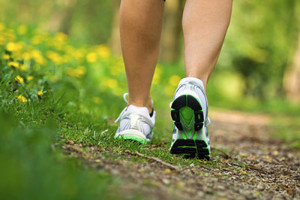 As running is an important activity, with up to as little as “five to 10 minutes of low-intensity running a day extend your life by several years,” our feet are a vital part of any kind of exercise. However, running is not without risk, as repetitive stress and impact from strenuous activity can lead to injuries such as runner’s knee, plantar fasciitis, pain, tears, and more. One tip for helping to build your stamina is to maintain a consistent exercise routine, slowly strengthening your muscles. Try cross-training with other activities to help build up your endurance. Take note of how you run, as poor form can increase the chance of an injury. When you run make sure your foot lands under your knee and avoid running when you’re tired.
As running is an important activity, with up to as little as “five to 10 minutes of low-intensity running a day extend your life by several years,” our feet are a vital part of any kind of exercise. However, running is not without risk, as repetitive stress and impact from strenuous activity can lead to injuries such as runner’s knee, plantar fasciitis, pain, tears, and more. One tip for helping to build your stamina is to maintain a consistent exercise routine, slowly strengthening your muscles. Try cross-training with other activities to help build up your endurance. Take note of how you run, as poor form can increase the chance of an injury. When you run make sure your foot lands under your knee and avoid running when you’re tired.
Exercising your feet regularly with the proper foot wear is a great way to prevent injuries. If you have any concerns about your feet, contact our podiatrists of Greater Queens Podiatry, PLLC. Our doctors will treat your foot and ankle needs.
How to Prevent Running Injuries
Many common running injuries are caused by overuse and overtraining. When the back of the kneecap starts wearing out and starts causing pain in your knee, this is commonly referred to as runner’s knee. Runner’s knee is a decrease in strength in your quadriceps and can occur if you’re not wearing properly fitted or supporting shoes. To prevent runner’s knee, focusing on hip strengthening is a good idea, as well as strengthening your quads to keep the kneecaps aligned.
What Are Some Causes of Running Injuries?
- One cause of a common running injury is called iliotibial band syndrome.
- Plantar fasciitis is also another common injury.
- Stress fractures can occur from overtraining, lack of calcium, or even your running style.
Best Ways to Prevent Running Injuries
- Wear footwear that fits properly and suits your running needs.
- Running shoes are the only protective gear that runners have to safeguard them from injury.
- Make a training schedule. Adding strengthening exercises as well as regular stretching can help keep you strong and limber and can lessen the possibility of injuries.
- Stretching keeps muscles limber; this will help you gain better flexibility.
If you have any questions please feel free to contact our office located in Bayside, NY. We offer the newest diagnostic and treatment technologies for all your foot and ankle needs.
Read more about How to Prevent Running Injuries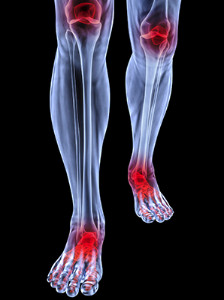 Arthritis is a very common disease that can affect joints in areas all over the body. Arthritis of the feet can be especially painful and debilitating due to the constant weight put on that section of the body. For someone with arthritic feet, every step taken can be excruciating. There are many different types of arthritis, though inflammatory arthritis can be one of the most devastating. Rheumatoid arthritis is one such type, where the cartilage of the joints is being destroyed. Though there is really no set diet to cure this illness, there are some recommended foods that may prove effective in helping mitigate some of the arthritic symptoms. The key is to reduce inflammation. Certain foods that help do just that are nuts, fish, and, dark vegetables.
Arthritis is a very common disease that can affect joints in areas all over the body. Arthritis of the feet can be especially painful and debilitating due to the constant weight put on that section of the body. For someone with arthritic feet, every step taken can be excruciating. There are many different types of arthritis, though inflammatory arthritis can be one of the most devastating. Rheumatoid arthritis is one such type, where the cartilage of the joints is being destroyed. Though there is really no set diet to cure this illness, there are some recommended foods that may prove effective in helping mitigate some of the arthritic symptoms. The key is to reduce inflammation. Certain foods that help do just that are nuts, fish, and, dark vegetables.
Arthritis can be a difficult condition to live with. If you are seeking treatment, contact our podiatrists from Greater Queens Podiatry, PLLC. Our doctors can provide the care you need to keep you pain-free and on your feet.
Arthritic Foot Care
Arthritis is a joint disorder that involves the inflammation of different joints in your body, such as those in your feet. Arthritis is often caused by a degenerative joint disease and causes mild to severe pain in all affected areas. In addition to this, swelling and stiffness in the affected joints can also be a common symptom of arthritis.
In many cases, wearing ill-fitting shoes can worsen the effects and pain of arthritis. Wearing shoes that have a lower heel and extra room can help your feet feel more comfortable. In cases of rheumatoid arthritis, the arch in your foot may become problematic. Buying shoes with proper arch support that contour to your feet can help immensely.
Alleviating Arthritic Pain
It is best to see your doctor for the treatment that is right for your needs and symptoms. Conditions vary, and a podiatrist can help you determine the right method of care for your feet.
If you have any questions, please feel free to contact our office located in Bayside, NY. We offer the newest diagnostic tools and technology to treat your foot and ankle needs.
Read more about Arthritic Foot Care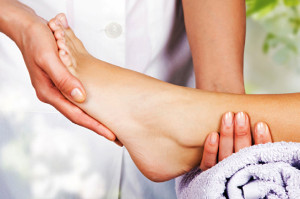 Known as a chronic autoimmune disease, lupus and its symptoms are similar to that of arthritis, affecting the tissues in the joints and leading to various problems in the feet including bunions, claw toes, and hammertoes. Lupus can also lead to tendonitis, loss of feeling or neuropathy, muscle inflammation, corns and calluses, swollen feet or oedema, and more. It is especially important to watch lupus symptoms, as infections such as gangrene can develop in a healthy person. Visit your podiatrist to assess your condition, as well as invest in proper footwear with insoles.
Known as a chronic autoimmune disease, lupus and its symptoms are similar to that of arthritis, affecting the tissues in the joints and leading to various problems in the feet including bunions, claw toes, and hammertoes. Lupus can also lead to tendonitis, loss of feeling or neuropathy, muscle inflammation, corns and calluses, swollen feet or oedema, and more. It is especially important to watch lupus symptoms, as infections such as gangrene can develop in a healthy person. Visit your podiatrist to assess your condition, as well as invest in proper footwear with insoles.
When dealing with systemic disease of the feet, it is extremely important to check the affected areas routinely so that any additional problems are caught quickly. If you have any concerns about your feet and ankles contact our podiatrists from Greater Queens Podiatry, PLLC. Our doctors will assist you with all of your podiatric needs.
Systemic Diseases of the Feet
Systemic diseases affect the whole body, and symptoms usually are displayed in the feet. This condition can make a patient’s ability to walk unbearable. Systemic diseases include gout, diabetes mellitus, neurological disorders, and arthritis.
Gout – is caused by an excess of uric acid in the body. Common symptoms include pain, inflammation, and redness at the metatarsal/phalangeal joint of the base big toe. Gout can be treated by NSAIDs to relieve pain and inflammation, and other drugs that lower the acid levels in the body.
Diabetes mellitus – is an increase in the level of blood sugar that the body cannot counteract with its own insulin. Failure to produce enough insulin is a factor in Diabetes.
Diabetes of the Feet
Diabetic Neuropathy – may lead to damaged nerves and affect the feet through numbness and loss of sensation.
Peripheral Vascular Disease – can restrict the blood flow to the feet, and often times lead to amputation of the feet.
If you have any questions please feel free to contact our office located in Bayside, NY. We offer the newest diagnostic and treatment technologies for all your foot and ankle needs.
Read more about Systemic Diseases of the Foot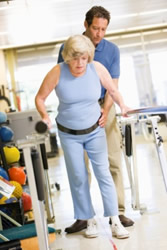 When we age, we gradually lose muscle and gain fat, which typically contributes to declines in strength and issues with gait and balance. A recent study published in the Journal of the American Geriatric Study examined the effects of various of forms of exercise in lowering fall risk. Findings concluded that while programs including brisk walking had no effect on falls, those that included resistance training and challenging balance exercises were extremely effective in preventing falls. Strength and resistance training, even for the elderly, can greatly improve gait and therefore decrease fall risk. Simple exercises such as balancing on one leg while lightly using a table or chair for support can help gauge balance and strength.
When we age, we gradually lose muscle and gain fat, which typically contributes to declines in strength and issues with gait and balance. A recent study published in the Journal of the American Geriatric Study examined the effects of various of forms of exercise in lowering fall risk. Findings concluded that while programs including brisk walking had no effect on falls, those that included resistance training and challenging balance exercises were extremely effective in preventing falls. Strength and resistance training, even for the elderly, can greatly improve gait and therefore decrease fall risk. Simple exercises such as balancing on one leg while lightly using a table or chair for support can help gauge balance and strength.
Proper foot care is something many older adults forget to consider. If you have any concerns about your feet and ankles, contact one of our podiatrists from Greater Queens Podiatry. Our doctors can provide the care you need to keep you pain-free and on your feet.
The Elderly and their Feet
As we age we start to notice many changes in our body, but the elder population may not notice them right away. Medical conditions may prevent the elderly to take notice of their foot health right away. Poor vision is a lead contributor to not taking action for the elderly.
Common Conditions
Neuropathy – can reduce feeling in the feet, and can hide many life threating medical conditions.
Reduced flexibility – prevents the ability of proper toenail trimming, and foot cleaning. If left untreated, it may lead to further medical issues.
Foot sores – amongst the older population can be serious before they are discovered. Some of the problematic conditions they may face are:
Gouging toenails affecting nearby toe
Shoes that don’t fit properly
Pressure sores
Loss of circulation in legs & feet
Edema & swelling of feet and ankles
Susceptible Infections
Diabetes and poor circulation can cause general loss of sensitivity over the years, turning a simple cut into a serious issue.
If you have any questions please feel free to contact our office located in Bayside, New York. We offer the newest diagnostic and treatment technologies for all your foot and ankle needs.
While proper foot care is important for everybody, senior citizens have the tendency to be more susceptible to certain conditions. The elderly should therefore be well informed about any problems that may arise and about what they can do to properly avoid or treat them.
Some of the most common foot problems seniors are susceptible to include foot ulcers, ingrown toenails, fallen arches, and fungal nails. A foot ulcer is an open sore on the foot and can be a result of diabetes and decreased sensation in the feet. An ingrown toenail is defined as when the nail grows into the side of the toe. Fallen arches are indicated by the instep of the foot collapsing. A fungal nails is a condition that results in deformed and discolored toenails.
In order to avoid these conditions it is recommended that the feet be inspected by the patient on a regular basis. If these inspections are carried out routinely, there is a good likelihood that problems can be identified before they become severe, or can even be avoided altogether. If any abnormality is discovered, it is important that the individual consult a podiatrist for diagnosis and information on treatment options.
Proper foot hygiene is also important. Making sure that you always have clean, dry socks on can be a major deterrent to many different problems including bacterial infections, foot odor, and certain types of fungus. Wet feet are a major cause of many of these problems. If your socks get wet, it is important to change them. Walking around in wet socks may not only lead to various infections, but can irritate the skin and result in a number of various complications. Clean, dry feet are less likely to be affected by fungal and other infections.
As people age, the fat present on your feet begins to deteriorate. The protective nature of this fat keeps the feet healthy by providing a barrier between your bones and the ground. This also aids in giving the skin on the feet a certain amount of elasticity. This is one factor that causes elderly people to develop some serious foot issues. Foot moisturizers can be helpful to avoid certain problems associated with this. However, water-based moisturizers do not work as well for elderly people as they do for the young. Instead, it is more effective to use an emollient instead. An emollient is effective because it binds the water in the foot, keeping it from becoming absorbed too readily which will result in dry skin. Emollients also have a special property called occlusion, which provides a layer of oil on the skin. This layer prevents the foot from drying up and can be very effective in treating dry skin disorders. If you can keep the skin on your feet healthy, this will substantially reduce the number of foot problems you will encounter in old age.
Proper footwear is another way to keep feet healthy. Shoes that fit well and provide proper support help prevent ingrown toenails and fallen arches.
Certain medical conditions such as diabetes or poor blood circulation increase the risk for foot issues. For individuals with any of these conditions it is extremely important to conduct regular foot inspections to make sure that there are no sores or infections present.
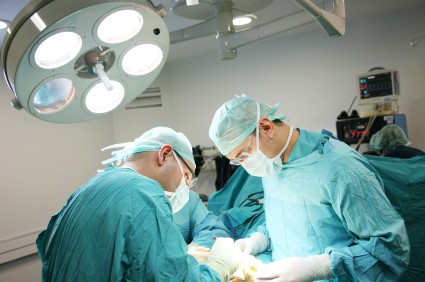 In a recent study focusing on the effects of shoes on women’s feet, 88% of the women included were wearing shoes that were too small for their feet. 356 women were included in the study. Most of the women had not re-measured their feet in over ten years, and over 50% stated that they experienced daily foot pain from their shoes. Wearing shoes that are too tight can make way for the development of foot conditions such as bunions, hammertoes, corns, and calluses, and can even result in surgery for the treatment or removal of such conditions. Surgery is often seen as the final option for the treatment of many of these conditions; to lessen the possibility of surgery and the development of these conditions in general, always wear shoes of the proper size.
In a recent study focusing on the effects of shoes on women’s feet, 88% of the women included were wearing shoes that were too small for their feet. 356 women were included in the study. Most of the women had not re-measured their feet in over ten years, and over 50% stated that they experienced daily foot pain from their shoes. Wearing shoes that are too tight can make way for the development of foot conditions such as bunions, hammertoes, corns, and calluses, and can even result in surgery for the treatment or removal of such conditions. Surgery is often seen as the final option for the treatment of many of these conditions; to lessen the possibility of surgery and the development of these conditions in general, always wear shoes of the proper size.
Foot surgery is sometimes necessary to fix a foot ailment. To learn more, contact Dr. Nicholas Megdanis from Greater Queens Podiatry PLLC. Our doctor can provide the care you need to keep you pain-free and on your feet.
When Is Surgery Necessary?
Foot and ankle surgery is generally reserved for cases in which less invasive, conservative procedures have failed to help with the problem. Some of the cases in which surgery may be necessary are:
● Removing foot deformities like bone spurs and bunions
● Severe arthritis that has caused bone issues
● Cosmetic reconstruction
What Types of Surgery Are There?
The type of surgery you receive will depend on the nature of the problem you have. Some of the possible surgeries include:
● Bunionectomy for painful bunions
● Surgical fusion for realignment of bones
● Neuropathy decompression surgery to treat nerve damage
Benefits of Surgery
Although surgery is usually a last resort, it can provide more complete pain relief compared to non-surgical methods and may allow you to finally resume full activity.
Surgical techniques have also become increasingly sophisticated. Techniques like endoscopic surgery allow for smaller incisions and faster recovery times.
If you have any questions please feel free to contact our office located in Bayside, New York. We offer the newest diagnostic and treatment technologies for all your foot and ankle needs.
In most cases, foot surgery is often chosen as the last available option for conditions that have otherwise been unsuccessfully treated. Surgery may be necessary for several reasons, including the removal of foot deformities (e.g. bone spurs or bunions), arthritis problems, reconstruction due to injury, and congenital malformations (e.g. club foot or flat feet). Regardless of one’s age, foot surgery may be the only successful option for treatment for certain conditions.
The type of surgery one undergoes depends on the type of foot condition the patient has. For the removal of a bunion growth, a bunionectomy is necessary. If the bones in the feet need to be realigned or fused together, a surgical fusion of the foot is needed. For pain or nerve issues, a patient may require surgery in which the tissues surrounding the painful nerve are removed. Initially, less invasive treatments are generally attempted; surgery is often the last measure taken if other treatments are unsuccessful.
While in many cases surgery is often deemed as the final resort, choosing surgery comes with certain benefits. The associated pain experienced in relation to the particular condition is often relieved with surgery, allowing patients to quickly resume daily activities. The greatest benefit, however, is that surgery generally eliminates the problem immediately.
Podiatry history has shown that foot treatments continue to evolve over time. In the field of foot surgery, endoscopic surgery is just one of the many advanced forms of surgery. As technology vastly improves so too will the various techniques in foot surgery, which already require smaller and smaller incisions with the use of better and more efficient tools. Thanks to such innovations, surgery is no longer as invasive as it was in the past, allowing for faster and easier recoveries.
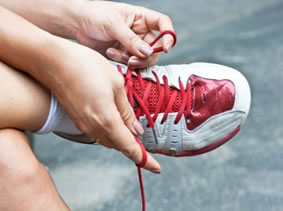 According to the American College of Foot and Ankle Surgeons (ACFAS), it’s important to keep your feet safe during the winter months with proper footwear. Proper winter footwear should provide traction against the snow and icy surfaces. The footwear should also keep your feet warm, insulated, and be water-resistant. Proper protection can help ward off against poor blood circulation caused by the cold. Wearing breathable, moisture-resistant socks can also offer greater protection, as keeping the feet dry is just as important as keeping them warm.
According to the American College of Foot and Ankle Surgeons (ACFAS), it’s important to keep your feet safe during the winter months with proper footwear. Proper winter footwear should provide traction against the snow and icy surfaces. The footwear should also keep your feet warm, insulated, and be water-resistant. Proper protection can help ward off against poor blood circulation caused by the cold. Wearing breathable, moisture-resistant socks can also offer greater protection, as keeping the feet dry is just as important as keeping them warm.
Finding a properly-fitting shoe is important in reducing injuries and preventing foot problems. For more information about treatment, contact one of our podiatrists from Greater Queens Podiatry PLLC. Our doctors will treat your foot and ankle needs.
Proper Shoe Fitting
A common concern when it comes to foot health, having properly fitted shoes can help prevent injuries to the foot. Out feet affect our posture and gait, which in turn affects the biomechanics and overall bodily structure. With 33 joints, 26 bones, and over 100 ligaments, the potential for serious injury is much greater than one realizes. Although the feet cease growth in adulthood, they still change shape as they mature. Here are some factors to consider when it comes to investing in proper fitting shoes:
● Be sure the shoes fit correctly right away
● Ensure the ball of your foot fits comfortably in the widest portion of the shoes
● Even though they may look fashionable, improper fitting shoes can either create adverse conditions or exacerbate existing ones you may already have
● Walk along a carpeted surface to ensure the shoes comfortably fit during normal activity
Keeping in mind how shoes fit the biomechanics of your body, properly-fitting shoes are vitally important. Fortunately, it is not difficult to acquire footwear that fits correctly. Be sure to wear shoes that support the overall structure of your body. Do your feet a favor and invest in several pairs of well-fitted shoes today.
If you have any questions please feel free to contact our office located in Bayside, New York. We offer the newest diagnostic and treatment technologies for all your foot and ankle needs.
| Bayside Office 4401 Francis Lewis Blvd Suite L3B Bayside, NY 11361 Phone: (718) 229-0222 Fax: (718) 717-0275 | Monday: 9:30am - 7pm |
E-mail us with any questions